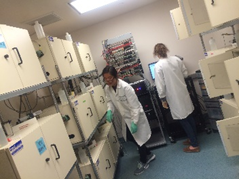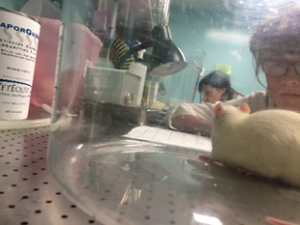This past week I have done many things that the average teenager would never do, including beginning my internship in addiction and neuroscience at The Scripps Research Institute in La Jolla, Calif., one of leading research centers in the world! I am joined there by my fellow Pinhead intern, Ella White. At the moment we are the only high school students in our building and have learned that very few high school students receive the honor of working in the addiction labs at all.
We’re living in Pacific Beach north of Mission Bay, which is just north of down town San Diego. We are roughly a mile and a half inland from the beach and when we aren’t working at Scripps we are surfing or sitting on the beach.
We have been working with Marsida who is an Albanian post-doc with a heart of gold. She is always glad to teach us all about her field of addiction which is Nicotine, and I don’t think I have ever heard her make a negative remark about anything. This week we learned the basics of the lab; how to handle the rats, how to clean their cages, how nicotine acts on the brain and which regions are influenced. We also got the opportunity to take part in some of the actual experiments that test nicotine withdrawal.
The first experiment we did is called the Von Frey experiment. In this experiment you have basically a toothbrush handle with a single small fiber where the bristles of the toothbrush would normally go. The rats are walking on cage wiring, that way you can get underneath the rat and press the fiber into their paw. There are fibers of varying thicknesses and the thickness judges the rigidity of the fiber. The thicker the fiber, the stiffer or more rigid it is. You start by pressing small fibers into the paw of the animal then move to larger fibers until the rat moves his paw.
When the rat moves its paw it means that the fiber has irritated the rat. Marsida had done a baseline to see what the rats’ pain tolerance was before they were exposed to nicotine, so we were testing whether the rats’ exposure to nicotine lowered their pain tolerance.
Our results were concurrent with this hypothesis.
Another test we did was an observation test. In this test we observed the rats for 10 minutes each after they had gone through 16 hours of withdrawal. We performed these tests on rats with four different exposures to nicotine; high, medium, low and naïve. In order to judge the withdrawal intensity the rat was experiencing we had to look for different signs such as: grooming, biting nails, licking genitals, blinking, teeth chattering, hair messiness (rats’ hair is generally flat to the body, but when distressed the hair spikes out), and how squinty their eyes are.
As most would expect, the high dose rats experienced the most symptoms, followed by the mediums. The lows and the naïve experienced the least.
I already love this internship and can’t believe that cutting edge scientists would allow high school students to participate in their experiments.



There are no comments published yet.